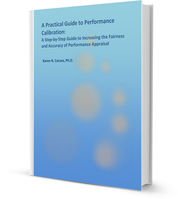Time to Step Up Your Leadership Game
 Managers sometimes assume that top performers do not need as much feedback, coaching and attention as average performers. We find that managers are often on autopilot in how they manage their best performers and then are shocked to find out that their most valuable talent was dissatisfied when they leave. Performance management is even more critical for high performers because they typically contribute more than their peers, and are looking for recognition of their significant contributions and feedback on how they can advance their careers.
Managers sometimes assume that top performers do not need as much feedback, coaching and attention as average performers. We find that managers are often on autopilot in how they manage their best performers and then are shocked to find out that their most valuable talent was dissatisfied when they leave. Performance management is even more critical for high performers because they typically contribute more than their peers, and are looking for recognition of their significant contributions and feedback on how they can advance their careers.
Performance review time is not the time to tell high performers: "You know you are doing a good job, there is no need to have a formal discussion." This sends the message that their stellar performance is not valued. As such, managers must step up their game in conducting employee performance reviews for high performers.
Balanced feedback is still the rule.
Although the performance review is likely to be glowing, you still must be specific in identifying both strengths and development needs for top performers. High performers have a desire to continually improve and seek to understand how they can enhance their performance and skills. Recognize the specific skills that represent strengths and clearly articulate the areas that can be improved. Glossing over one or the other does a disservice to the individual and the organization. Focus development suggestions on growth and stretch opportunities and provide this information in the written comments section as high performers may already be off the quantitative charts. Discuss how strengths can be leveraged across projects and shared through the mentoring of others.
Provide performance examples.
High performers are likely to want to see evidence and specific examples that support performance ratings. Don’t think you can slide with generic themes. Be prepared to offer descriptions of what has been done well and/or behaviors that should be improved for future success. This shouldn’t be an issue as long as you have been documenting performance examples throughout the year (you have haven’t you?).
Learn more on how to be specific and helpful in providing feedback by reading the following article: Awesome Performance Feedback in Employee Performance Management.
Use multi-rater feedback.
In the same way that performance examples can provide the recognition high performers are looking for in order to buy-in, so too can multi-rater or 360 feedback give context and color to everyday performance. High performers pride themselves on their organizational networks and will look favorably upon a performance review process that considers the broad impact they have on the organization. They want you to know that they are driving value throughout the company. Don’t miss this opportunity to provide a full picture of performance. Want to learn more about using multi-rater feedback in the performance review process? Click here to download the eBook: Are You Ready for 360?
No surprises.
High performers know they deliver more than their peers and as such, they always have a leg up in the retention game. While providing balanced feedback is critical, the last thing you want to do is surprise them during the performance review process with something negative that they weren’t expecting. Such surprises are likely to increase their flight risk (typically a very costly loss). As high performers are difficult to replace, feedback throughout the year that is designed to highlight their significant strengths, as well as challenge them to achieve their true potential is a must.
Advise on derailers.
Many high performers have extremely solid technical skills and generally very high competency ratings as well. Still, under stressful conditions fallback behaviors that are out of line for an accomplished leader can emerge. Help them recognize common derailers such as arrogance, perfectionism, volatility, etc. and rein them in before they can damage an otherwise successful career in the making.
Is your company struggling to identify true high performance? Download our Practical Guide to Performance Calibration to find some solutions.

